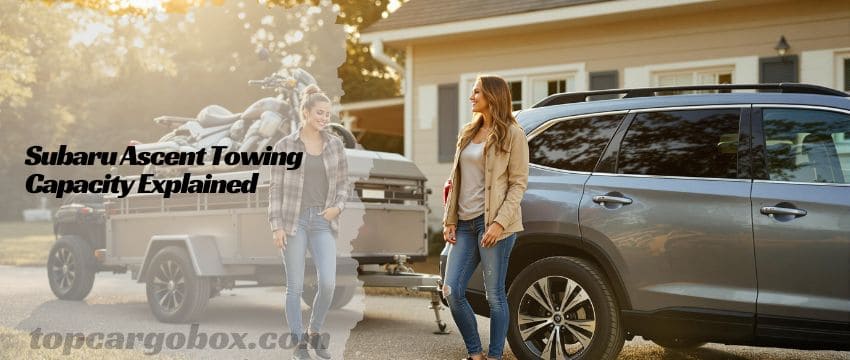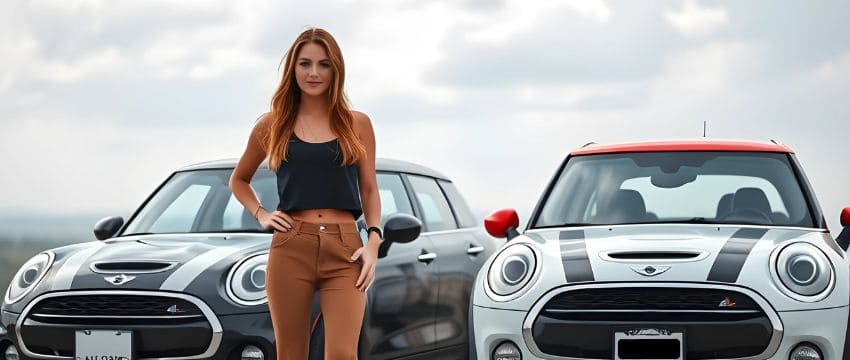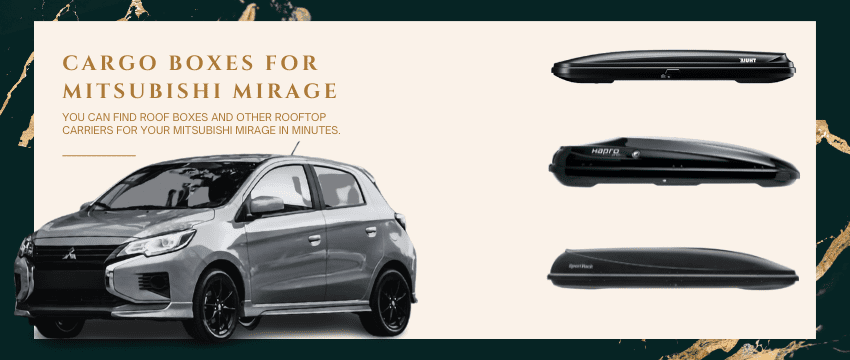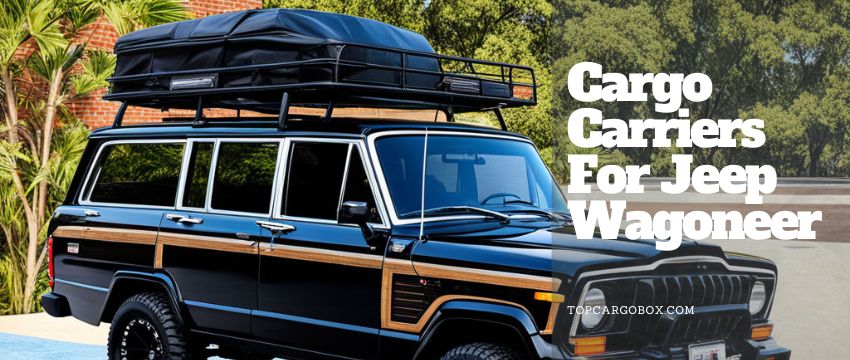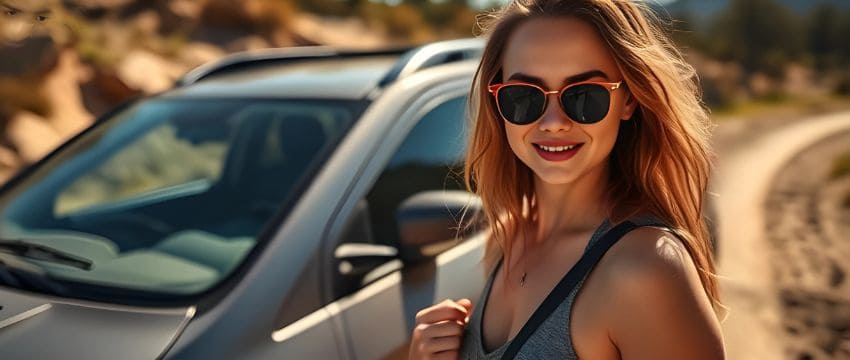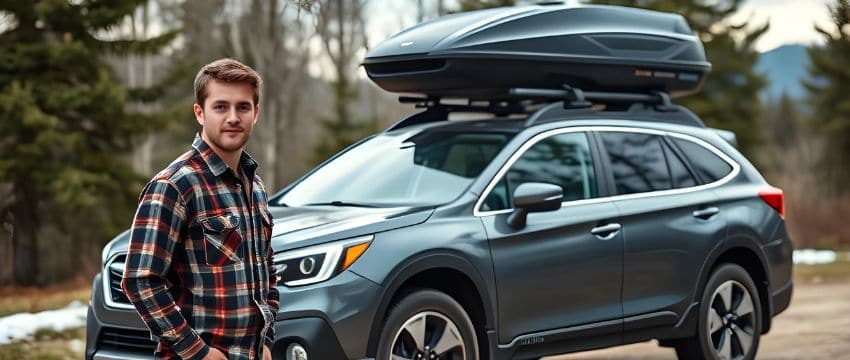How’s it going, Subaru Ascent Drivers? So, you’ve got your eye on the Subaru Ascent, or maybe you’re already cruising in one, and you’re dreaming about hooking up a camper, boat, or trailer for that next big escape. Totally get it! But that nagging question hits: “Can this family hauler really handle the load?” Let’s cut through the confusion and dive deep into the Subaru Ascent’s towing muscle, specifically for camping and RVs. Buckle up, because we’re covering everything you need to know to tow confidently and safely. For real, understanding this stuff is the difference between an epic road trip and a roadside nightmare. Ever wonder exactly what “5,000 lbs” means for your real-world plans? We’re breaking it down, piece by piece.
Understanding the Ascent’s Towing Muscle
Alright, let’s get straight to the headline number everyone talks about: the Subaru Ascent boasts a maximum towing capacity of 5,000 pounds. That’s awesome, right? It puts it firmly in the mix for pulling decent-sized travel trailers, pop-up campers, boats, and utility trailers. But hold up, don’t just run out and buy the biggest 25-footer you see! That 5,000 lb figure isn’t a free pass; it’s the absolute ceiling under perfect conditions. Think factory tow package, absolutely nothing else in the car except the driver, ideal weather, perfectly flat ground… you get the idea. Reality, especially when you’re loading up for a camping trip, is almost always different.
What does this number actually include? It’s the maximum weight the trailer itself can weigh when fully loaded (that’s the Gross Trailer Weight, or GTW). Crucially, this does NOT include the weight of your passengers, your gear inside the Ascent, your dog, or that massive cooler full of snacks and drinks. Forgetting this distinction is where many folks get into trouble. Think about it: you wouldn’t try to lift your max bench press weight after running a marathon, would you? Same principle applies here. Towing near the limit demands respect for the entire system.
Quick-Pick List of 6 Towing accessories For Subaru Ascent:
Image | Items | Links |
|---|---|---|
 | CURT 13448 Trailer Hitch – A 2-inch receiver hitch designed for the Subaru Ascent, offering durable towing capacity. It features a straightforward installation and robust construction for reliable performance. | |
 | CURT 13400 Trailer Hitch – A 2-inch receiver hitch compatible with the Subaru Ascent, providing a secure towing solution. Its design ensures easy mounting and strong hauling capability. | |
 | The CURT 13382 Class 3 Trailer Hitch features a heavy-duty 2-inch receiver with a 3,500-lb towing capacity, built from powder-coated alloy steel for rust resistance and tested to SAE J684 safety standards for reliable hauling. Paired with the CURT 56040 4-Pin Wiring Harness, this kit provides a plug-and-play trailer light connection (no cutting/splicing) for select Subaru models, offering seamless compatibility with standard 4-flat trailer lighting systems. | |
 | The Genuine Subaru OEM Trailer Hitch Towing Kit is a high-quality, crash-tested hitch designed specifically for the 2019-2025 Ascent, offering a robust 5,000-lb towing capacity (or 2,000 lbs for base models) with a powder-coated, corrosion-resistant finish. Engineered to meet Subaru’s strict safety standards, this kit includes the hitch and wiring harness (hitch ball and mount sold separately) for secure, compliant towing while maintaining the vehicle’s factory performance and durability. | |
 | The Oyviny 4-Pin Trailer Wiring Harness is a plug-and-play aftermarket wiring kit designed for select Subaru models (2009-2024 Ascent, Crosstrek, Forester, and Outback) with a factory tow package. It features a 4-way flat connector, pure copper wiring, and a direct battery connection to prevent electrical overload. This harness ensures easy installation without cutting or splicing, while its durable, weather-resistant design (including a dust cover and 7.5A fuse) provides reliable trailer light, brake, and turn signal functionality for various towing needs. | |
 | The SKKYORO Rear Bumper Hitch Access Cover is a direct replacement for the OEM trailer hitch cover (part #57731XC07A) on 2019-2022 Subaru Ascent models, made from durable ABS plastic for long-lasting protection. Designed for a perfect fit, this cover requires no modifications for installation and provides a seamless, factory-like appearance while shielding the hitch from dirt and damage. |
Key Components for Towing 5,000 Pounds
Hitting that 5,000 lb mark isn’t just about the engine’s grunt (though the 2.4L turbo helps!). Subaru requires specific, factory-installed equipment to safely achieve this capacity. What’s the magic combo? You absolutely need the factory-installed tow hitch receiver and the integrated trailer wiring harness. No big deal, right? Well, trying to slap on an aftermarket hitch and wiring might work for lighter loads, but if you’re aiming anywhere near 5,000 lbs, skipping the factory setup is a gamble you don’t want to take. Why’s the factory setup so critical? It’s not just about the metal.
The Ascent’s engine cooling system, transmission programming, and even the vehicle’s stability control are all optimized and calibrated to work seamlessly with that specific factory tow package when pulling heavy loads. An aftermarket hitch might be physically strong enough, but it won’t communicate with the car’s brain the same way. Think of it like using the right fuel for a high-performance engine. Using the correct, integrated system ensures everything works together smoothly and safely under stress. Would you trust a critical safety system to a generic part? Probably not. This factory setup gives you that integrated safety net.
The Critical Role of Payload Capacity
Okay, payload capacity. This might be the most overlooked factor by new towers, but it’s absolutely crucial. What is it? Payload is the maximum weight your Ascent can carry inside itself. We’re talking passengers, driver, kids, dogs, luggage, camping gear, the kitchen sink you’re taking, and the weight pressing down on the hitch from the trailer (called tongue weight). Seriously, this is where the math gets real. You can find your Ascent’s specific payload capacity on a yellow and white sticker inside the driver’s door jamb. Don’t ignore this sticker! It’s your gospel for safe loading. Typical Ascent payloads range between roughly 1,400 lbs and 1,700 lbs, depending on the trim level and options (heavier trim levels = less available payload).
Here’s the kicker: That 5,000 lb trailer will typically exert a tongue weight of 500 to 750 lbs (aim for 10-15% of the trailer’s total weight). That tongue weight? It counts directly against your payload. So, if you have 1,500 lbs of payload, and 600 lbs of that is tongue weight, you only have 900 lbs left for everything else inside the car. Four adults averaging 175 lbs each is already 700 lbs, leaving just 200 lbs for luggage, coolers, kids, the dog… you see how quickly it evaporates? Exceeding payload is dangerous – it strains suspension, brakes poorly, and makes the vehicle unstable. Ever felt a car sag badly with too many people? Imagine that at highway speeds with a trailer pushing you. Not good.
Here’s a quick look at the core specs:
Feature | Specification | Notes |
|---|---|---|
Max Towing Capacity | 5,000 lbs | Requires Factory Tow Package (Hitch & Wiring) |
Engine | 2.4L Turbocharged Boxer 4-Cylinder | Produces 260 HP & 277 lb-ft Torque |
Transmission | Lineartronic CVT (Continuously Variable) | Features “Manual” Mode with 8 Simulated Speeds for Towing |
Factory Hitch Receiver | Class III (2″ receiver opening) | Mandatory for achieving 5,000 lb capacity |
Integrated Wiring | 7-Pin Connector Standard with Tow Package | Provides power for trailer brakes & lights |
Typical Payload Range | ~1,400 lbs – 1,700 lbs | Check YOUR specific door jamb sticker! Critical for loading. |
Max Tongue Weight | 500 lbs (10% of 5,000 lbs) | Aim for 10-15% of trailer GTW for stability. Can eat payload quickly. |
Trailer Sway Control | Standard with Factory Tow Package | Integrated system helps mitigate trailer sway |
X-MODE | Standard | Enhances control on low-traction surfaces (helpful for launching boats) |
Choosing the Right Camper or RV
So, what size camper can you actually pull with an Ascent? It’s the million-dollar question, right? Forget the dry weights advertised on shiny RV brochures. Seriously, they are almost meaningless. Those weights don’t include propane, batteries, fresh water, your bedding, food, dishes, clothes, or the mountain bikes strapped to the back. Realistically, with the Ascent’s 5,000 lb max and the payload constraints, you need to be looking at trailers with a dry weight significantly under 4,000 lbs, ideally in the 3,500 lb to 4,200 lb range. Why so low? Because by the time you load it up for a week-long trip, you’ll easily add 800 lbs to 1,500 lbs (or more!). Think: Water weighs over 8 lbs per gallon. A 30-gallon tank? That’s 240 lbs right there! Common types that fit well:
- Pop-Up Campers (Tent Trailers): Often dry between 1,200 lbs and 2,800 lbs. Loaded, many stay comfortably under 3,500 lbs. Awesome for families, lighter on the Ascent, and offer a great camping feel.
- Small Travel Trailers (Bunkhouses & Hybrids): Look for models specifically designed for “small tow vehicles”. Dry weights 2,800 lbs to 4,000 lbs are the sweet spot. Expect loaded weights 3,800 lbs to 4,800 lbs. Crucially, you MUST confirm the final loaded weight (GTW) and ensure tongue weight stays manageable. Models like the Jayco Jay Feather Micro, Forest River R-Pod, or smaller Coachmen Apex Nano fit here.
- Teardrop Trailers: Usually very lightweight (1,000 lbs to 2,500 lbs loaded). Super easy tow for the Ascent, leaving tons of payload for gear inside the car. Perfect for couples or small families prioritizing simplicity.
- Small Toy Haulers: Extreme caution needed! While some ultra-light models exist, their unique design (empty garage space at the back) often leads to higher tongue weights even when “empty”. Do your homework meticulously.
What about larger trailers? Let’s be real honest. A 25-foot trailer, even if advertised at 4,500 lbs dry, will almost certainly blow past 5,500 lbs loaded. Plus, the wind resistance on a big box becomes a huge factor, straining the engine and transmission constantly. Is it worth the stress and risk? Probably not. Choosing a trailer well within your limits makes the journey safer and way more enjoyable. Remember, it’s not just about getting it moving; it’s about controlling it safely downhill, in crosswinds, and during emergency stops. Feeling that big trailer push you around isn’t fun. Trust me.
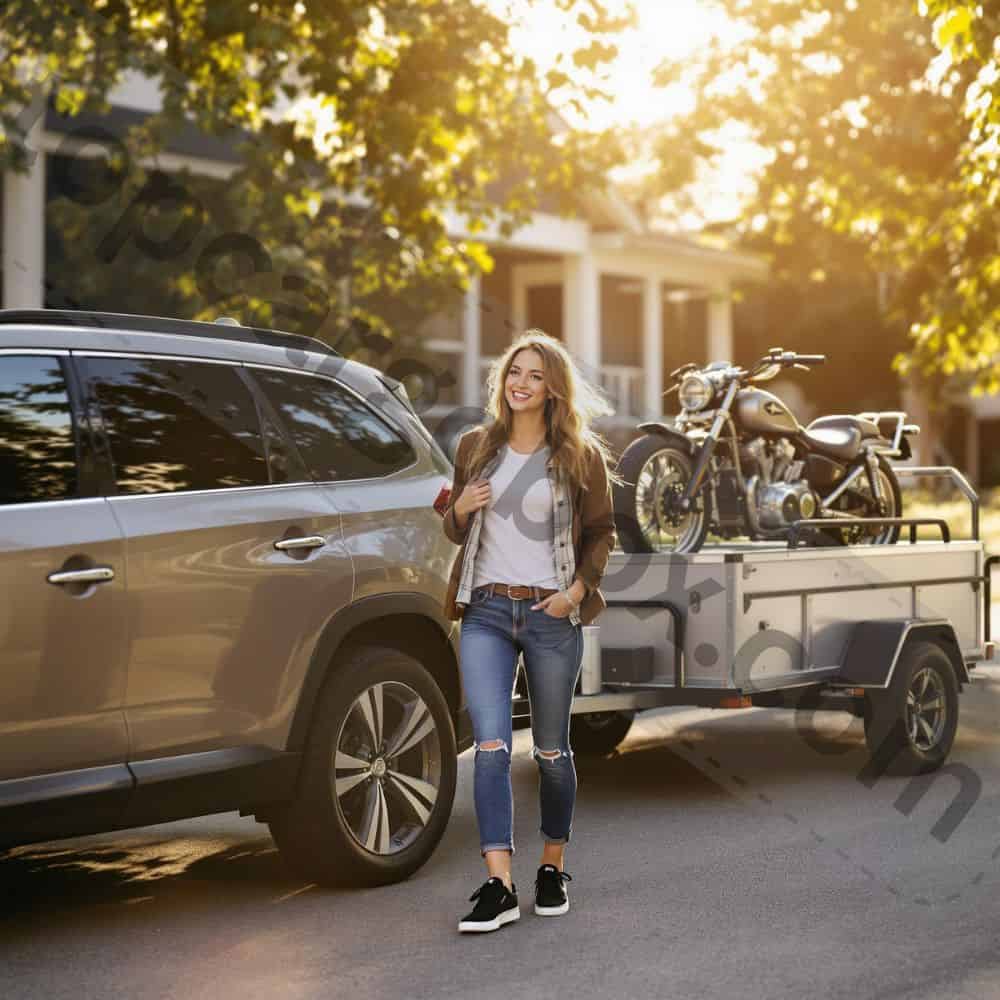
Essential Towing Gear & Accessories
Alright, so you’ve got your trailer picked out (smartly within limits!). Now, what else do you really need? Going beyond the factory hitch and wiring is non-negotiable for safe, stress-free towing. First up: Weight Distribution Hitch (WDH) with Sway Control. This isn’t optional gear for travel trailers over about 2,500 lbs. How does it work? A WDH uses spring bars to redistribute some of the tongue weight back onto the trailer’s axles and, crucially, onto the front axle of your Ascent.
Why does that matter? It keeps the front wheels planted for better steering and braking, levels out the ride (no more sagging rear end!), and significantly reduces the tendency for trailer sway. Integrated sway control adds friction to dampen side-to-side motion. Think of it as training wheels and a stabilizer for your trailer. Brands like Equal-i-zer, Blue Ox, and Husky Centerline are popular. Getting this setup professionally installed and dialed in is worth every penny.
Next: Brake Controller. If your trailer has electric brakes (which any decent-sized camper or RV will), you legally and practically NEED a brake controller in your Ascent. How’s it going to stop otherwise? This device, mounted inside your cabin, allows you to manually activate the trailer brakes and, more importantly, automatically applies them proportionally when you hit your brakes, based on how hard you stop. No big deal? Actually, it’s a huge deal for safety and preventing the trailer from pushing you through an intersection. Redarc, Tekonsha, and Curt make reliable models. Some integrate cleanly with the Ascent’s dash.
Mirror Extensions: Your factory mirrors won’t cut it. You need to see around the trailer. Clip-on or tow-specific mirror extensions are cheap and essential for safe lane changes and backing up. Don’t even think about towing without them.
Hitch Accessories: A good ball mount sized correctly for your trailer coupler and a high-quality, appropriately rated ball (likely a 2″ ball for travel trailers) are basic necessities. Don’t cheap out here! A locking hitch pin is also wise. Finally, consider cargo management solutions. Roof boxes like the Thule Motion series (check out our comparison on the Thule Motion 3 L vs XL can free up precious interior payload space. High-quality hitch cargo carriers are another great option (we reviewed some excellent cargo carriers for the Ascent). Moving bulky, lightweight items (chairs, tents, sleeping bags) outside the vehicle preserves payload for heavier essentials and people.
Mastering the Towing Experience
You’ve got the gear, the trailer’s hitched up, payload’s checked twice… now what? Driving a 4,000+ lb box behind you is different. Let’s talk technique. First, take it slow. Acceleration will be way more gradual. Dude, don’t gun it off the line; you’ll strain the CVT unnecessarily. Use the Ascent’s “Manual” mode (those paddle shifters!) to lock the CVT into a lower “gear” ratio, especially helpful for maintaining speed on hills without the transmission constantly hunting.
This provides more engine braking on descents too – crucial! How do you handle hills? Build momentum before the incline, use manual mode to hold a lower gear, and don’t be afraid to let speed drop somewhat rather than flooring it. Coming down is often trickier. Again, manual mode is your friend. Shift down early to use engine braking, saving your actual brakes from overheating. Feeling the trailer push? That’s why engine braking is vital.
Braking requires much more space and anticipation. Start slowing down way earlier than you normally would. That brake controller is doing its job, but the total mass is immense. Smooth is key. Jerky braking can induce trailer sway. Speaking of sway… if you feel it starting, DO NOT slam on the brakes. That makes it worse. Gently ease off the accelerator and carefully use the manual trailer brake control (the lever or button on your brake controller) to try and straighten it out. If you have a WDH with sway control, it should help dampen it significantly. Crosswinds and passing big trucks will push you around. Be prepared, grip the wheel firmly but stay relaxed, and make small, smooth corrections. Keep your eyes far down the road. Scanning ahead gives you more time to react.
Tire pressures are critical. Check them cold – meaning before you’ve driven more than a mile or two. Your Ascent’s door jamb sticker lists the recommended pressure for normal driving. When towing, you often need to increase rear tire pressure significantly (consult your manual or tire manufacturer, but increases of 5-10 PSI or more are common). Underinflated tires overheat and can fail, especially under heavy load.
Check trailer tire pressures religiously too! Finally, watch your temperatures. The Ascent’s turbo works harder when towing. Keep an eye on the coolant temp gauge. If you’re climbing a long, steep grade on a hot day, it might creep up. If it gets uncomfortably high, find a safe place to pull over, shift to Park, and let the engine idle for a few minutes to cool down (the fans will run). Turning off the A/C can also help reduce engine load temporarily.
Real-World Ascent Towing Stories
Enough theory! What’s it really like? Let’s hear from folks actually doing it. Take Sarah and Mike, parents of two young kids and proud Ascent Touring owners. They pull a 2022 Jayco Jay Feather Micro 166FDS (dry weight ~3,200 lbs). “Loaded for a week at the lake, we’re probably around 4,300 lbs,” Sarah estimates. “We use a Blue Ox WDH. Honestly, on flat highways, you barely know it’s back there. The Ascent handles it like a champ.
Hit some decent mountain passes last summer – it slowed down, sure, but manual mode kept it steady. Averaged about 14 MPG for the trip, which we expected. The biggest challenge is payload. With the four of us, the dog, and the hitch weight, we have to be really careful about what goes inside the car. We put all the light, bulky stuff in a roof box (finding good cargo solutions is key). Would we want a bigger trailer? Sometimes, but then we’d need a bigger truck, and we love the Ascent for daily life.”
Then there’s Ben, an avid mountain biker. He tows a small, single-axle utility trailer carrying 4 dirt bikes (total trailer weight ~2,200 lbs). “No WDH needed for this light setup, just the factory hitch and a brake controller. The Ascent pulls it effortlessly. MPG drops to maybe 17, but it’s predictable. The symmetrical AWD is awesome on dirt roads getting to the trailheads, even with the trailer. Keeping the bikes secure and managing dust inside the trailer are my bigger headaches!”
These stories highlight the sweet spot: trailers under ~4,500 lbs loaded, with proper gear and careful packing. Pushing the absolute max? One owner we spoke to briefly towed a borrowed trailer rated at 4,900 lbs dry. “Loaded, it was definitely over 5,500 lbs,” he admitted. “The Ascent moved it, but it was stressful. Struggled on hills, braking felt marginal, and fuel economy tanked to 10-11 MPG. I white-knuckled it the whole way and wouldn’t do it again. Not worth the risk or the strain on the car. Sold me on staying well within the limits.”
Keeping Your Ascent Towing Strong
You love your Ascent, and you want it to last through many adventures, right? Towing adds significant stress, so maintenance becomes even more critical. First and foremost: transmission fluid. The Lineartronic CVT works hard when towing. Subaru used to say “lifetime fluid,” but no reputable transmission expert believes that, especially for towers. Seriously, ignore the ‘lifetime’ myth. Best practice? Get the CVT fluid changed more frequently.
Many experienced towers and mechanics recommend every 30,000 to 60,000 miles if you tow regularly, versus the standard severe service schedule (if your manual even lists one for towing). Check your owner’s manual for specific guidance under “towing” or “severe duty” maintenance. When in doubt, change it sooner rather than later. Clean fluid is cheap insurance against expensive transmission failure.
Engine oil changes are next. Stick religiously to the severe service schedule in your manual, which usually means changes every 3,000 to 5,000 miles when towing frequently. The turbo runs hotter, and the engine works harder. Use high-quality synthetic oil meeting Subaru’s specifications. Brakes wear faster too. Inspect pads and rotors more often. Listen for squealing and pay attention to braking feel. Flushing the brake fluid every 2 years is wise, as heat from towing can degrade it faster.
Cooling system health is paramount. Ensure coolant is at the proper level and mixture. Have the system flushed according to the severe schedule. Check radiator fins for debris – bugs, leaves, mud – especially after trips. A clogged radiator can’t cool effectively. Tires are your connection to the road. Rotate them regularly (every 5,000 miles is good under towing stress) and monitor tread depth and signs of uneven wear, which could indicate alignment issues or suspension problems aggravated by the load. Replace tires sooner if needed; don’t push them to the wear bars.
Pre-Trip and Post-Trip inspections are non-negotiable. Before you hook up: Check all trailer lights (running, brake, turn signals). Inspect trailer tires for wear, cracks, and proper inflation. Look under the trailer for leaks (oil, grease, water). Ensure hitch, coupler, safety chains, and breakaway cable are secure and in good condition. Verify the brake controller is working. Check Ascent tire pressures (adjusted for load!). After the trip: Give everything another once-over. Look for any new leaks on the Ascent or trailer. Check for any unusual smells (burning) or noises that might have developed. Clean off your WDH components to prevent rust. Taking 15 minutes for these checks can save you hours (or worse) on the roadside. Feeling overwhelmed? Build a simple checklist and keep it in your glove box.
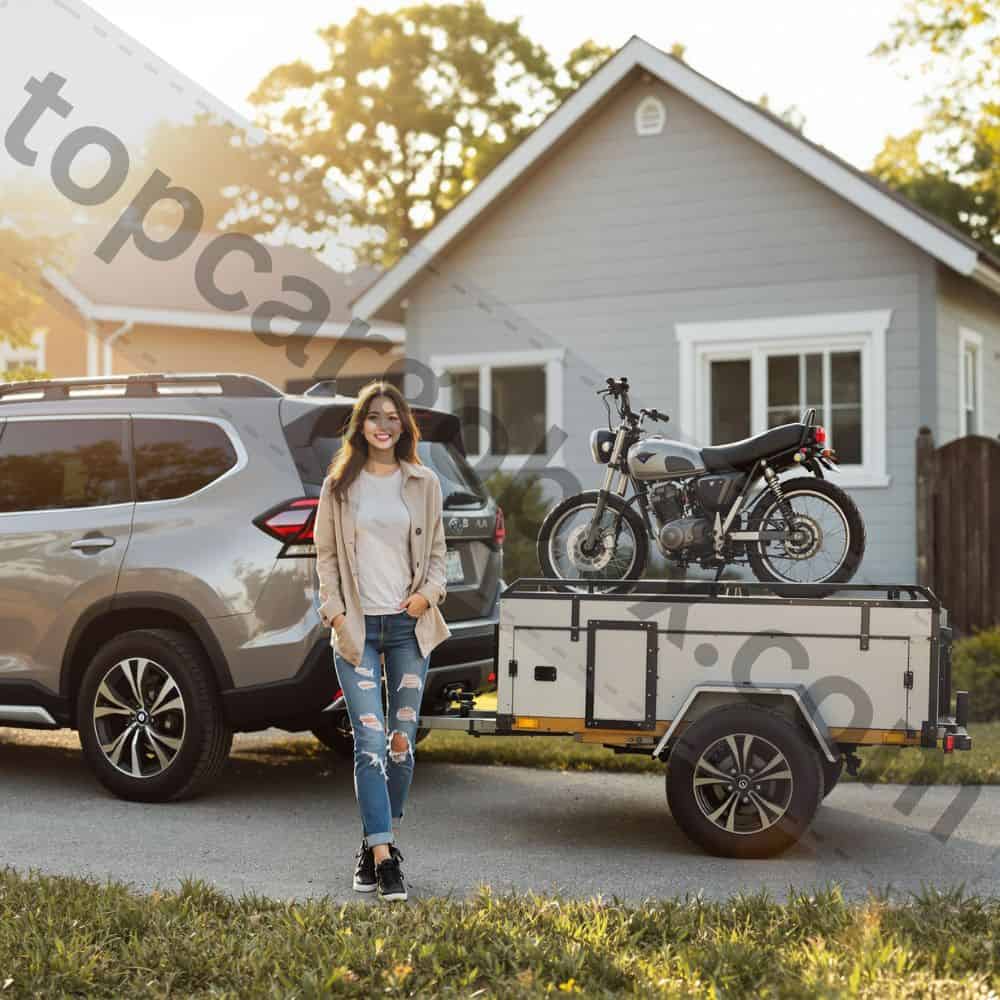
Awesome Camping Setup Ideas
Towing the camper is just the start! How do you make the Ascent itself the ultimate basecamp? Let’s talk gear organization and comfort. Cargo management is king. We mentioned roof boxes and hitch carriers – absolutely essential for freeing up interior payload space. Beyond the carriers we reviewed (check out these Ascent cargo options), consider cargo baskets or even a roof-top tent if you want to go full adventure mode (remember, that adds weight up high!).
Inside, organizers are lifesavers. Seat-back organizers for kids’ stuff, trunk bins or dividers to keep gear from becoming a shifting avalanche, and a sturdy cargo net or barrier for pets. Window shades are a must for keeping the car cool and giving privacy when napping or changing. Portable power solutions like a Jackery or EcoFlow power station let you charge devices, run a small fridge/freezer, or power lights without idling the car. Solar panels can recharge them during the day.
Don’t forget creature comforts! A good quality air mattress that fits in the back with the seats down transforms the Ascent into a surprisingly cozy sleeper for two in a pinch. Quality sleeping bags rated for the expected temps. Camp chairs that pack down small. A portable camp table. A reliable camp stove and mess kit. Water storage jugs (remember the weight!). A comprehensive first-aid kit. Recovery gear like traction boards and a basic tool kit if you venture off paved roads. Lighting: Headlamps for everyone, plus lanterns or string lights for the campsite. Pro tip: Pack a small “camp kitchen” bin with essentials (plates, cups, utensils, sponge, soap, towel, basic spices, coffee maker) so it’s always ready to grab.
Another one: Use clear plastic bins inside the car so you can see what’s where without unloading everything. Label them! Finally, ensure you have clear visibility. If you’re driving through bug country or rain, having the best windshield wipers is crucial for safety. Don’t get caught with streaky wipers in a downpour! Setting up camp should be fun, not a frantic search for the spatula. A little organization goes a long way.
Why the Ascent Rocks for Camping (Beyond Towing)
Look, the towing capacity is a huge perk, but the Ascent is an amazing camping rig even without a trailer. Its true strength lies in its versatility. Symmetrical All-Wheel Drive? Game changer. This isn’t some marketing gimmick; it’s a legit, full-time system that provides incredible confidence on dirt roads, sandy beaches, muddy forest trails, or snowy mountain passes getting to those dispersed campsites. X-MODE enhances this further, optimizing torque distribution and braking for gnarlier terrain. Ground clearance? At 8.7 inches, it eats up obstacles that would stop minivans or many crossovers cold.
The interior is cavernous with seats folded. Seriously, the cargo space is massive. Easily sleeps two adults comfortably (with an air mattress), or hauls gear for a whole family car-camping trip. Roof rails are standard, ready for kayaks, canoes, bikes, or that massive roof box carrying your tents and sleeping pads. Visibility is excellent all around, making it easy to navigate tight spots or spot wildlife.
Comfort matters on long drives. Supportive seats, a quiet cabin, and standard features like Apple CarPlay/Android Auto make the journey part of the adventure. Available heated seats (front and rear!) and a heated steering wheel are glorious on chilly mornings. Fuel efficiency is respectable for a 3-row SUV, especially when you’re not towing – you can expect real-world MPG figures similar to what many experience in other Subaru models on highway trips.
Safety features like EyeSight (adaptive cruise, lane keep assist, pre-collision braking) are standard and reduce driver fatigue on long hauls. Essentially, the Ascent packs the soul of a Subaru adventure wagon into a practical, family-sized package. It gets you to the wild places reliably and comfortably, carries all your gear (or sleeps you!), and yes, when equipped right, can tow a very capable camper. That’s a pretty awesome combo, right?
Conclusion: Towing Smart with Your Subaru Ascent
So, can your Subaru Ascent be your camping and RV towing hero? Absolutely! But the key is realistic expectations and meticulous preparation. Respect that 5,000 lb maximum as the absolute limit, not the target. Seriously, aiming for trailers with loaded weights comfortably under that figure – think 4,000 to 4,500 lbs max – is the path to safe, enjoyable, and sustainable towing. Never, ever forget payload capacity. That door jamb sticker is your bible. Factor in tongue weight first, then people, then gear. Invest in the essential gear: The factory tow package is mandatory for heavy loads, a Weight Distribution Hitch with Sway Control is non-negotiable for travel trailers, and a brake controller is essential for safety.
Maintain your Ascent diligently, especially transmission and cooling systems. Pack smart and use cargo solutions like roof boxes or hitch carriers (we’ve got recommendations) to maximize your usable payload. Learn proper towing techniques – take it slow, use manual mode, brake early, and watch temperatures. Choose your camper wisely, focusing on lightweight models like pop-ups, teardrops, and smaller travel trailers. Done right, the Ascent is a remarkably capable and comfortable tow vehicle for creating unforgettable family camping adventures without needing a massive, gas-guzzling truck. Ready to hit the road? Go explore, stay safe, and make some epic memories!
Your Burning Subaru Ascent Towing Questions, Answered
What size camper can a Subaru Ascent pull?
Alright, let’s cut to the chase about what your Ascent can actually handle without breaking a sweat or stressing you out. Forget those shiny brochure “dry weights” – no kidding, they’re basically useless fantasy numbers once you load up propane, water, food, and all your gear. Totally get it, you want the biggest rig possible, but for safe, enjoyable trips, you need to aim for campers tipping the scales at a fully loaded weight (that’s everything in it, folks!) between 4,000 and 4,500 pounds, max.
Seriously, look for the lightweights: think nimble travel trailers, easy-going pop-ups (tent trailers), cool teardrops, or hybrids specifically built for vehicles like yours. How do you feel when you see those tiny trailer weights? Yeah, ignore that hype. Off the top of my head, models like the Airstream Basecamp, Winnebago Micro Minnie, or smaller Grand Design Imagine XLS often fit this smarter approach way better than trying to muscle something massive. Nice try, brochures, but we live in the real world where a pop-up packed for fun might weigh 2,500 to 3,500 pounds, and a compact travel trailer realistically hits 3,800 to 4,800 pounds ready for adventure.
Here’s the real kicker, though: finding the trailer’s actual loaded weight is only half the battle. You absolutely must know its tongue weight too – figure roughly 10-15% of that total loaded weight – and then double-check it leaves enough breathing room on your Ascent’s payload sticker (remember that yellow tag in your door jamb?). How’s it going to handle if the tongue weight plus your crew, the dog, and the cooler stuffed with ice and drinks maxes out your payload? Not well, my friend.
Squeezing in a trailer pushing 4,800 pounds might seem doable on paper, but if its tongue weight is a hefty 650 pounds and your payload limit is 1,500 pounds, suddenly you’ve only got 850 pounds left for everything else inside your SUV. Four adults and a kid? That could easily be 700 pounds right there, leaving almost nothing for luggage! Going bigger than this sweet spot isn’t just a maybe-problem; it’s legit flirting with exceeding hard limits, making your rig unstable, stressing every component, and honestly, just sucking the fun right out of your getaway. Your Ascent will thank you for playing it smart.
Can the Subaru Ascent really tow 5000 lbs?
Technically yes, but practically, it’s extremely challenging and often unwise for camping. The 5,000 lb rating requires the factory tow package and represents the maximum under ideal conditions with only a driver. In real-world camping scenarios, you have passengers, gear inside the car, and the trailer’s tongue weight eating into your payload capacity long before you hit 5,000 lbs on the trailer. Adding all your camping essentials to the trailer easily pushes a “5,000 lb dry” trailer well over 5,500 lbs. Towing near the absolute max strains the engine, transmission, brakes, and significantly reduces safety margins. It’s far smarter and safer to choose a lighter trailer.
Is the Subaru Ascent good for camping?
Absolutely! The Ascent is an outstanding camping vehicle, even if you’re not towing. Its standard Symmetrical AWD and 8.7 inches of ground clearance confidently handle dirt roads, beaches, and mountain trails to reach remote sites. The huge cargo area with fold-flat seats swallows massive amounts of gear or easily converts into a comfortable sleeping space for two. Standard roof rails are perfect for kayaks, bikes, or cargo boxes. Comfortable seats and good fuel efficiency make long drives pleasant. Safety features like EyeSight add peace of mind. Whether car-camping, basecamping, or towing a small trailer, the Ascent’s versatility, capability, and space make it a top-tier choice for adventurers.
How much weight can my Subaru Ascent tow?
Okay, let’s bust open that big “5,000 pounds” number Subaru advertises – yeah, your Ascent can technically pull that much, but only if it rolled off the dealer lot with the official Subaru hitch and wiring setup already bolted on. For real, that factory package isn’t just a suggestion; it’s the golden ticket letting your SUV flex its max muscle. But here’s the catch everyone discovers the hard way: that 5,000-pound dream is almost never what you can safely haul day-to-day. Why’s that? Your payload capacity – y’know, that little yellow sticker hiding in your driver’s door jamb – is the real boss here.
Think about it: hooking up a trailer that heavy means its tongue is gonna shove down on your hitch with a serious 500 to 750 pounds of force, and that weight, plus every single thing inside your car (you, the kids, Fido, the giant cooler, suitcases…), all eats into that precious payload number. How’s it going to handle if you’re maxed out just on tongue weight and passengers? Not awesome. So, while the brochure shouts 5,000, the smart money says your actual safe, comfortable zone for towing that camper, loaded with all your gear, is way more likely sitting between 3,500 and 4,500 pounds. Always, always check payload first – it’s the unsung hero that keeps your adventure smooth and safe, not sweating bullets on the highway. Nice try, pushing that absolute max, but your payload sticker doesn’t lie.
What is the best Subaru for towing a camper?
Among current Subaru models, the Subaru Ascent is unequivocally the best for towing campers. It has the highest maximum towing capacity at 5,000 lbs (with factory package). The Subaru Outback comes next, with a maximum of 3,500 lbs (also requiring a specific factory option on newer models – learn more about Outback towing receivers). While capable for smaller pop-ups or teardrops, 3,500 lbs is significantly less than the Ascent’s limit. The Forester and Crosstrek max out at 1,500 lbs, suitable only for very small, light trailers or utility hauling. For dedicated camper/RV towing, especially for families needing space, the Ascent’s combination of 5,000 lb capacity, 3-row seating, and ample cargo room makes it the clear Subaru champion.
Does maximum towing capacity include vehicle weight?
No, absolutely not. Maximum towing capacity refers only to the maximum allowable weight of the trailer and its contents (the Gross Trailer Weight – GTW). It does not include the weight of the Subaru Ascent itself, the passengers inside it, the fuel, or any cargo loaded into the Ascent. Think of it as the maximum load you can pull behind your vehicle. The weight of your vehicle, plus everything in it (including people and gear), is governed by the Gross Vehicle Weight Rating (GVWR), which is a separate limit found on the same door jamb sticker as payload. Payload capacity (also on the sticker) is the difference between your Ascent’s actual curb weight and its GVWR – it’s the maximum weight you can add to the vehicle (people, gear, AND tongue weight). Confusing payload with towing capacity is a common and dangerous mistake.
Our team is creating outdoor-gear relevant articles with passion. If our articles can help you to find the correct solutions for your questions, we will be happy about that. In the content creation process, we usually collect accurate and useful information online or offline to compile our content in an organized way. Consequently, we can guarantee that you can discover some expected answers to your questions. We appreciate your time on our site.

